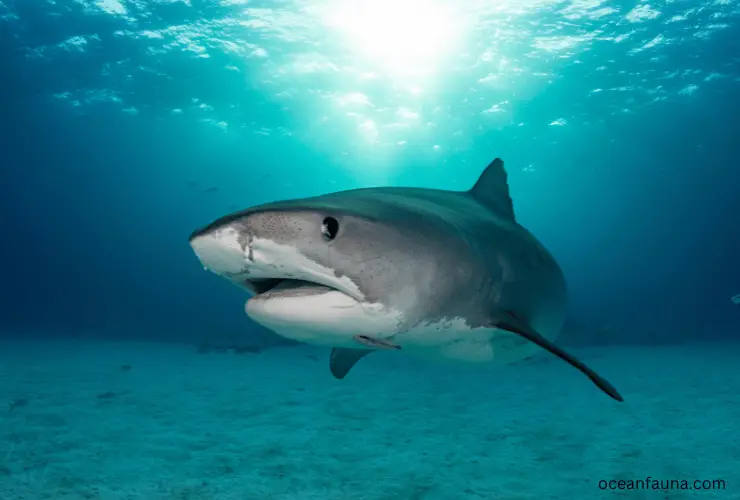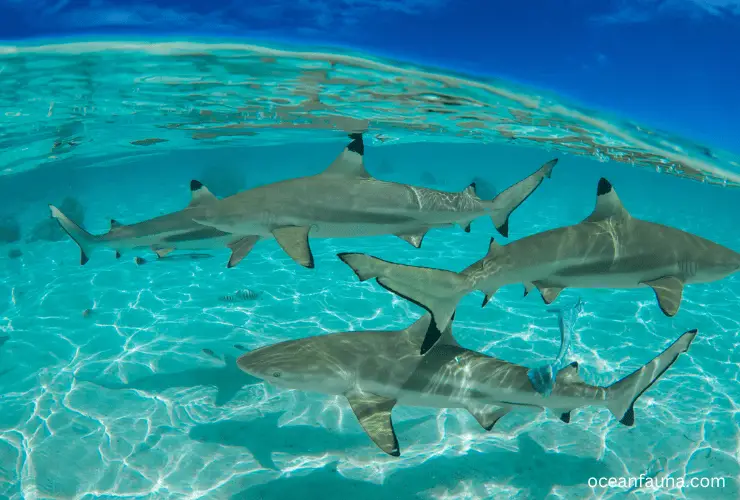Do sharks make noise to communicate?
No, sharks can’t make any noise to communicate since they lack vocal cords. Now the big question is how do sharks communicate when they can’t make a sound. Sharks communicate, expressing themselves through their movements, body language, chemical signals, and electroreceptor organs.
If you’re eager to learn more about the ways sharks express themselves, this article is for you! I’ll be taking an in-depth look at their behaviors and how they communicate with each other. So read on – your curiosity will be satisfied!
Do Sharks Communicate?
Sharks maybe some of the ocean’s ultimate predators, but recent research has shown that these species are capable of complex social behaviors, including maintaining long-term relationships and working together in teams.
For example, studies have found that lemon sharks can form social alliances with each other and recognize individuals with whom they have interacted before. Additionally, it has been observed that great white sharks travel in groups, with some individuals acting as leaders to others.
These behaviors indicate a level of communication between shark species that goes beyond simple predator/prey interactions. In order to form alliances or work together in teams, sharks must be able to clearly pass information between one another – they must be able to communicate effectively.

In addition to forming social connections within their own species, sharks also appear to use communication to avoid conflict when dealing with other shark species.
For instance, when sand tiger sharks come into contact with members of other species, they display behavior similar to what is known as “passive aggression”: swimming away quickly or charging but not attacking the other animal.
The observer could interpret this as an indication from the sand tiger shark that it does not want confrontation and would prefer if the other animal stayed away from its territory.
How Do Sharks Communicate?
You know that sharks don’t have vocal cords. So, sharks mainly communicate by relying upon body language, olfactory signals, and specialized electroreceptive organs.
How do sharks communicate with non-verbal body language?
They open their jaws, nod their heads, arch their bodies and use slapping displays as social signals between two sharks “talking” to each other. By doing so, they can effectively express a wide variety of emotions, such as aggression, dominance, or submission.
Sharks may also use body language to communicate with prey by displaying threatening movements or behaviors that deter them from approaching.
When a shark needs to decide which way to go or how fast it should swim, the motion of its tail plays a vital role in communicating its intentions to other sharks.
When swimming alongside another shark, it may raise its tail out of the water in warning before it decides to change directions. This is known as ‘tail-slapping’ and serves as a warning signal for others not to move toward that area of the ocean.
Similar to humans using facial expressions to convey emotions and feelings, some species of shark, such as leopard sharks, will actively expose their teeth when feeling threatened or aggressive towards one another.
While this behavior is quite rare in most species of shark, it allows them to quickly establish dominance when two competing for resources in an area need to be resolved quickly without prolonged conflict.
How do sharks communicate with olfactory signals?
In addition to physical communication with other sharks and prey, sharks are also able to pick up on chemical signals in the surrounding water. This communication is olfactory communication. These signals can tell them information about food sources and potential dangers nearby. Sharks also apply this in the case of reproduction.
By sensing these chemical cues in the water, they can determine where predators have been and if there is prey nearby that they should investigate further.
How do sharks communicate with their electroreceptors?
Surprisingly, some species of deep-sea sharks also rely heavily on electric fields for communication purposes by producing electric organ discharges (EODs).
By releasing low-voltage electrical pulses into the water around them, they are able to detect and alert other sharks within 100 meters of danger or potential food sources in a given area – making this one of the unique forms of communication seen among any marine animals!
How Do Sharks Interact with Non-Sharks?
Sharks can interact with other animals except for sharks in various ways, depending on the species of shark and the animal. Generally speaking, sharks are mostly predatory animals, meaning they hunt other animals for food. As a result, most of the time, when sharks interact with other animals, it is to hunt or kill them.
However, some species of sharks are not active predators and tend to feed primarily on plankton and small fish. These types of sharks will typically avoid contact with larger prey items. Sharks also often occupy different areas of the ocean than many other animals, so their interactions are usually brief.

Sharks typically have a very hierarchical social structure within their own species. Dominant males will often aggressively defend their territories against intruding males, while females may work together to protect young from predators. When interacting with other species, however, most shark species will stay away from anything large enough to be considered a predator themselves.
In some cases, different species of sharks can actively compete for resources such as food or shelter. This competition can be quite fierce in some cases where two different shark species may become involved in physical confrontations over rights to certain areas or resources within an ecosystem.
Moreover, there have been reports of some shark species displaying curious behaviors towards humans when scuba diving or swimming in coastal areas inhabited by sharks.
These encounters often involve either playful biting or circling behavior as if out of curiosity rather than aggression and sometimes even gentle touching though these encounters are rare and should not be considered typical interactions between sharks and other animals.
Do Sharks Communicate with Humans?
Yes, sharks do communicate with humans in certain ways. Through their behavior and body language, they can send various signals to show that they are aware of a diver’s presence.
Different species of sharks have different ways of communicating and displaying emotions, ranging from subtle changes in posture to more aggressive outbursts such as tail slapping or biting.
Generally speaking, sharks tend to interact with divers cautiously, often circling around them or approaching cautiously before swimming away again. This is thought to be an assessment process as the shark tries to determine whether the person is a threat.
When sharks are more comfortable with divers around them, they may approach closer and linger for longer periods. Some species may even interact directly with divers by gently bumping into them or nudging them with their noses.
It is important to note that these behaviors vary greatly depending on the species and individual shark, so it is always important for divers to exercise caution when interacting with sharks underwater.
Although some researchers have tried analyzing shark behavior towards people, it is extremely difficult to determine precisely how they communicate and what specific signals mean.
Sharks possess a range of facial expressions and postures which appear related to their moods, but these need further study in order to form any concrete conclusions about communication between them and humans.
Sharks are highly intelligent animals capable of learning from past experiences, so it is likely that their interactions with divers increase over time if they perceive no threat from them.
There have been numerous cases throughout history where divers have formed relationships with individual sharks over the course of several years by consistently respectfully interacting with them.
This hints at an ability on the part of the shark to both recognize individuals and remember past interactions in order to create long-term associations with human beings.
Are Sharks Capable of Communicating Through Urine?
Research into whether or not sharks are capable of communicating through urine is inconclusive. While they have been observed to have a heightened sense of smell, allowing them to detect the odor of other sharks’ urine, no scientific evidence suggests that this technique has any communicative purpose.
Sharks are sophisticated hunters and possess an extremely keen sense of smell in order to locate prey in the ocean. They can detect chemical compounds that signify food up to one part per million in the water around them, making it possible for them to locate prey from hundreds of feet away.

In addition, their highly developed olfactory bulbs enable them to easily detect other sharks’ urine. However, it is unclear whether this ability has communicative value among the animals.
Some scientists believe that sharks may be able to use urinary signals to communicate with each other, as they often travel in large groups and could potentially require some sort of long-distance communication system.
By releasing specific types and concentrations of chemicals into their environment through urination, they could send out signals or messages warning other sharks of potential danger or alert them to nearby food sources.
Unfortunately, there have been no definitive studies conducted on this topic so far, and the exact role that urine plays in shark behavior remains a mystery.
Do Sharks Have Feelings?
Yes, sharks have feelings. Sharks are complex creatures, and like many animals, they can experience a range of emotions. While it is clear that sharks don’t always show these feelings in the same way as mammals do, there is evidence of more active emotional responses.
For example, some sharks display signs of sadness or depression when subjected to stressful situations such as poor feeding, handling, or captivity. Other observations include increased aggression when an individual shark is removed from its group, and isolated or even vocalization in which they produce sounds similar to crying out.
Due to their anatomy, sharks do not have the same facial features as mammals, so interpreting their emotions can be difficult. However, further research on shark behavior has uncovered other clues of emotion within the species.
Scientists examining Tiger Sharks have found that they often become agitated when exposed to unfamiliar objects and humans, while Great Whites display shyness around new areas and people. These behaviors suggest that sharks possess a level of intelligence and understanding that allows them to feel emotions such as fear or anxiety in certain situations.
Beyond this, different species of shark demonstrate different levels of social interaction with one another; some species will form large communities, while others prefer solitary living.
This suggests that even among the more sociable shark species, there is a capacity for empathy since members will actively interact with one another during mating rituals or when hunting for food together.
Additionally, sharks also exhibit signs of parental care by providing protection from predators for their young and helping them find food sources until they are mature enough to survive on their own – behavior that indicates feelings such as love and concern for offspring.
Conclusion
Hopefully, you now understand the basics of how sharks communicate with each other, and other creatures, including humans. If your interest is not yet satiated, consider consulting a marine biologist or shark expert to gain more detailed insight into their behavior and interactions.
This knowledge can be incredibly beneficial in ensuring that we co-exist peacefully with these majestic animals so their habitats may remain safeguarded for future generations.


3 thoughts on “How Do Sharks Communicate?”